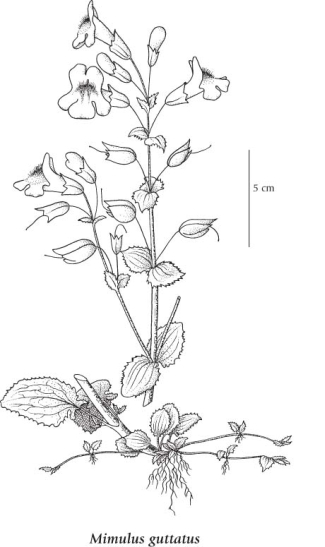yellow monkey-flower
Scrophulariaceae (Butterfly-bush family)
Introduction to Vascular Plants
Species Information
General:
Annual herb from fibrous roots or a perennial from a creeping stolon, rarely from a rhizome; stems stout and erect or sometimes weak and trailing and rooting at the nodes, 5-80 cm tall, simple or branched, smooth or sparsely hairy above.
Leaves:
Opposite, broadly oval to egg-shaped, 1-10 cm long, coarsely and irregularly toothed, palmately 3- to 7-veined from the base, smooth to thinly hairy, the lower leaves stalked, the upper leaves becoming unstalked, clasping-based, reduced in the inflorescence.
Flowers:
Inflorescence a loose, terminal raceme of several to many, or sometimes 1 to few, long-stalked flowers in the axils of the upper leaves, the stalks 1-4 cm long; corollas tubular, broadly funnel-shaped, yellow with maroon markings in the flaring throat, 1-3 (4 ) cm long, strongly 2-lipped, the lips spreading, the upper lip 2-lobed, the lower 3-lobed, densely yellow-hairy at the throat; calyces bell-shaped, green dotted or tinged with red, smooth or minutely hairy, 6-17 mm long in flower, to 20 mm and asymmetrically swollen in fruit, 5-toothed, the upper tooth larger than the others; stamens 4.
Fruits:
Capsules, broadly oblong, rounded at the tip, narrowed to a short-stalked base, 7-12 mm long; seeds numerous, 0.4-0.5 mm long.
Notes:
The ssp. haidensis has been recognized in the Queen Charlotte Islands, but it may not be much different from some of the numerous other forms previously named in this complex (see Hitchcock et al. 1959).
Illustration

If more than one illustration is available for a species (e.g., separate illustrations were provided for two subspecies) then links to the separate images will be provided below. Note that individual subspecies or varietal illustrations are not always available.
Illustration Source: The Illustrated Flora of British Columbia
Ecology
The table below shows the species-specific information calculated from
original data (BEC database) provided by the BC Ministry of Forests and Range.
(Updated August, 2013)
| Site Information |
Value / Class |
||
|
Avg |
Min |
Max |
|
| Elevation
(metres) |
733 | 0 | 2125 |
| Slope
Gradient (%) |
18 | 0 | 150 |
|
Aspect (degrees) |
185 | 5 | 359 |
| Soil
Moisture Regime (SMR) [0 - very xeric; 4 - mesic; 8 - hydric] |
5 | 0 | 8 |
| Modal
Nutrient Regime
Class |
D | ||
| #
of field plots species was recorded in: |
95 | ||
| Modal
BEC Zone Class |
CWH | ||
|
All BEC Zones (# of stations/zone) species was recorded in |
At(1), BAFA(1), BWBS(2), CDF(1), CWH(21), ESSF(2), ICH(12), IDF(2), MH(8), MS(3), PP(1), SBPS(6), SBS(14) | ||
|
Source:
Klinkenberg 2013
|
|||
Habitat and Range
Wet open sites, including seepage areas, meadows, waterfall spray zones, streambanks, springs, gravel bars, rock ledges and crevices, ditches and clearings in the lowland, steppe, montane and subalpine zones; common throughout BC; N to AK and S YT, E to SK, disjunct to NB and NFand S to PA, MI, NE, NM, AZ, CA and MX.Status Information
Synonyms
Synonyms and Alternate Names:
Mimulus guttatus DC.
Taxonomic Notes
Genetics:
Yellow monkey-flower exhibits a leaf-spot polymorphism similar to that in blue-eyed Mary (Collinsia parviflora) and clover ((Trifolium willdenowii). The spots, however, are usually more brownish in colour and usually cover the basal parts of the leaf, although pattern is variable. Frequently the large brown area at the base of the leaf makes the leaf appear to be dying. The spot is caused by anthocyanin pigments in the upper epidermis, and, like gene-expression in blue-eyed Mary, the expression of the gene is controlled by temperature. The distribution of phenotype frequencies parallels that in blue-eyed Mary and clover on the Flat Top Islands, but the gene for spots is perhaps more widespread in monkey-flower, as we have seen populations polymorphic for spotted leaves as far south as Kern County, California. Like spotting in other species, spotting in monkey-flower is controlled by a single gene, with the allele for spots dominant. We have found that the variation found in this kind of leaf-spotting is due to modifier genes separate from the leaf-spot gene itself. Source: Griffiths and Ganders. 1983. Wildflower Genetics: A Field Guide for British Columbia and the Pacific Northwest. Gardening: A charming BC native monkey flower with large very showy bright yellow flowers with red spots that are offered in masses in spring. Deserves to be grown in more gardens. Loves moist to average soils. Note Author: Gary Lewis, Phoenix Perennials |